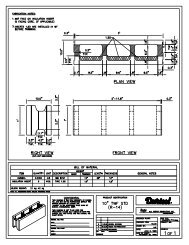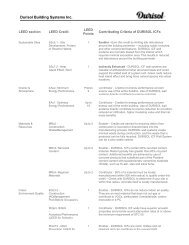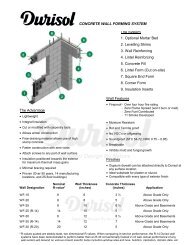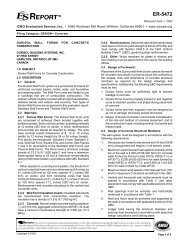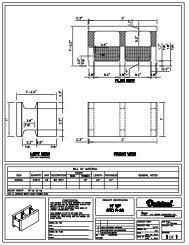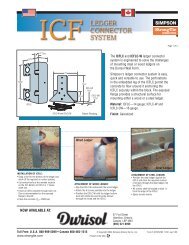M A T E R I A L S A F E T Y D A T A S H E E T - Durisol Building ...
M A T E R I A L S A F E T Y D A T A S H E E T - Durisol Building ...
M A T E R I A L S A F E T Y D A T A S H E E T - Durisol Building ...
You also want an ePaper? Increase the reach of your titles
YUMPU automatically turns print PDFs into web optimized ePapers that Google loves.
M A T E R I A L S A F E T Y D A T A S H E E T<br />
Current Issue Date: March 2006<br />
SECTION I – MATERIAL IDENTIFICATION AND USE<br />
Trade Name: DURISOL<br />
Manufacturer’s Name: <strong>Durisol</strong> <strong>Building</strong> Systems Inc.<br />
Address: 57 Arthur Street<br />
Mitchell, Ontario, Canada<br />
N0K 1N0<br />
Material Name: Wood Concrete<br />
Material Use: Construction materials<br />
Chemical Name: Not applicable<br />
Chemical Family: Light weight precast Portland cement product<br />
Chemical Formula: Cement bonded wood particle material<br />
SECTION II – HAZARDOUS INGREDIENTS OF MATERIAL<br />
<strong>Durisol</strong> is a mixture of inert wood aggregate, Portland cement, water and cement additives.<br />
Hazardous Ingredients<br />
Portland cement (CAS 65997-15-1) 20 – 30 % by volume<br />
SECTION III – PHYSICAL DATA FOR MATERIAL<br />
Physical State: Solid<br />
Appearance: Grey porous surface<br />
Odour Threshold: None<br />
Specific Gravity: 0.5 – 0.8<br />
Vapour Pressure: Not applicable<br />
Evaporation Rate: Not applicable<br />
Boiling Point: Not applicable<br />
Freezing Point: 0 Degrees Celsius<br />
SECTION IV – FIRE AND EXPLOSION HAZARD OF MATERIAL<br />
Non-combustible<br />
®<br />
1
SECTION V – REACTIVITY DATA<br />
Not applicable<br />
SECTION VI – TOXICOLOGICAL PROPERTIES OF MATERIAL<br />
Sawing or other demolition techniques may result in exposure to dust and larger particles containing<br />
ingredients of Portland cement which, when in contact with water, produce calcium hydroxide with an<br />
alkalinity level of pH 12 to pH 13. This level of alkalinity can cause skin and eye irritation.<br />
Effects of Chronic Exposure:<br />
Cement dust can cause inflammation of the tissue lining, the interior of the nose and the cornea (white) of<br />
the eye. Hyper-sensitive people may develop allergic dermatitis.<br />
Portland cement is not known to constitute a carcinogenic, reproductive, teratogenic, or mutagenic<br />
hazards.<br />
SECTION VII – PREVENTATIVE MEASURES<br />
Personal Equipment: When sawing or using other demolition methods, wear safety glasses<br />
and a dust mask.<br />
Engineering Controls: Provide ventilation when sawing or using other demolition techniques to<br />
maintain low dust concentrations.<br />
Waste Disposal: At approved landfill or waste disposal sites in accordance with local<br />
regulations.<br />
Handling Procedures<br />
& Equipment: As above<br />
Storage Requirements: Not applicable<br />
Shipping Information: Not applicable<br />
SECTION VIII – FIRST AID MEASURES<br />
Wash exposed areas of the skin with soap and water; Irrigate eyes with water<br />
SECTION IX – PREPARATION DATE OF MSDS<br />
Prepared by: John deGraauw<br />
Telephone: (519) 348-4900<br />
Preparation Date: October 1995<br />
Current Issue Date: March 2006<br />
®<br />
2




